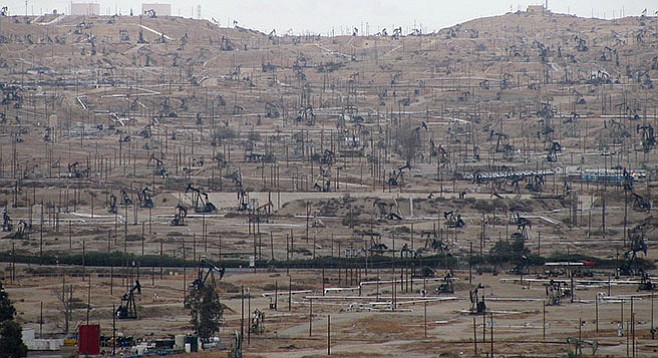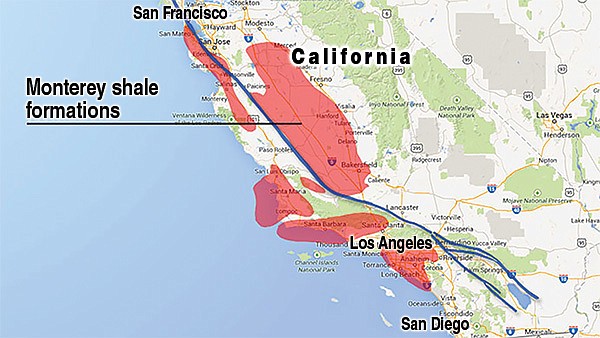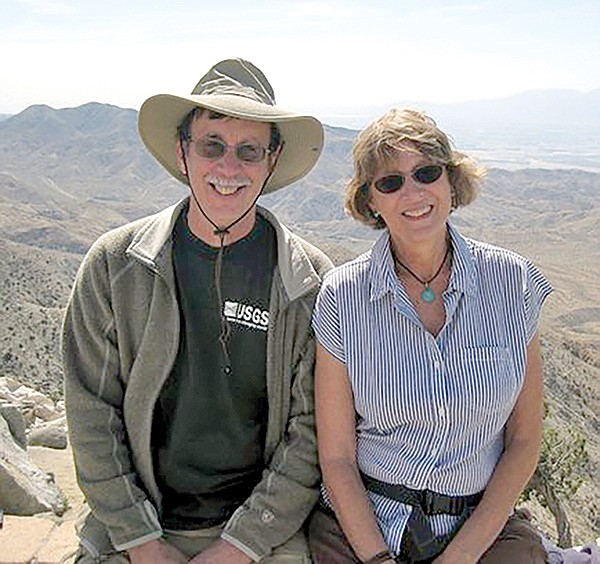 Facebook
Facebook
 X
X
 Instagram
Instagram
 TikTok
TikTok
 Youtube
Youtube

Fracking is hydraulic fracturing, or horizontal shooting of water, sand, and chemicals into shale to bring up oil and gas. However, people complain of loud equipment, stealing of water, and widespread pollution through use of chemicals said to be dangerous. The industry disputes these complaints. In any case, San Diego should not be vulnerable to fracking. The Monterey Shale Formation, from which oil and gas are pumped, stretches from Northern California to Los Angeles — sometimes zigzagging into the ocean and inland — bypassing San Diego County.

But San Diegan Nicola Peill-Moelter, who has a doctorate in environmental engineering science and is on the steering committee of SanDiego350, says we shouldn’t be so smug. Fracking in other locations, including the ocean, can poison the food we eat. Any water San Diego County receives from the north could cause fracking-related health problems. Fracking now gets the blame for many earthquakes. (Because of fracking, Oklahoma has supplanted California as the big earthquake state.)

Among many scary things, fracking threatens groundwater, hastens climate change, soaks up precious water during droughts, causes earthquakes, threatens endangered wildlife, spreads toxic chemicals, and spews toxic wastewater into the Pacific Ocean, says Peill-Moelter.
San Diegans William and Rosemarie Alley have written a book, High and Dry: Meeting the Challenges of the World’s Growing Dependence on Groundwater, published by Yale University Press this year. William Alley, also a PhD, is the director of science and technology for the National Ground Water Association. His wife Rosemarie is a science writer.
They are aware of fracking’s environmental degradations but take a nuanced view. For example, fracking-industry executives solemnly swear there are no documented cases of groundwater contamination resulting from fracking. Anti-fracking activists say that fracking sends cancer-causing chemicals into the environment and that groundwater supplies have been broadly contaminated. “The truth lies somewhere in between,” says the book.

William Alley says in an interview that the additional oil and gas produced by fracking may one day make the United States energy-independent — a goal that politicians strive for. Also, fracking definitely gets the credit for bringing oil and gas prices down, thereby permitting consumers to spend money on other things, boosting the U.S. economy.
American fracking has had an effect on our international relations. “OPEC [the Organization of the Petroleum Exporting Countries] lowered prices to do a knockout punch on fracking,” says William Alley. “Russia doesn’t like it. A number of people believe Russia instituted anti-fracking moves.”
Lower prices aren’t revered in Middle Eastern countries, either.
While our nation is benefitting from lower energy prices, there are big costs, too. Earthquakes are one of them. The blame lies in the disposal of wastewater from fracking. “For every one barrel of oil, there are ten barrels of water, and that water is contaminated, sometimes with arsenic,” says Peill-Moelter. The companies have to get rid of that water. So they dump it in deep underground structures, and this process results in the earthquakes, scientists believe.
“The life span of a well is very limited,” says Peill-Moelter. Companies are “getting most of their production in the first three years.” Three years ago, the U.S. Energy Information Administration slashed the estimated amount of recoverable oil from the Monterey Shale deposits by 96 percent. Overall, the process is expensive.
Then there are philosophical and environmental objections to fracking. Fracking perpetuates reliance on fossil fuels at a time when renewable energy sources (solar, wind, hydro, et cetera) represent the future, says William Alley. He explains, however, that there will be a substantial period in which the world will have to rely on fossil fuels before renewables take over.
Clearly, fracking has definite downsides, particularly environmental ones. Greater-than-expected amounts of methane, a potent greenhouse gas, have been leaking from operations and going into the atmosphere. Some scientists say that fracked wells leak 40 to 60 percent more methane than conventional gas wells. And methane may trap 20 to 25 times more heat in the atmosphere than does carbon dioxide. Result: fracking may hasten climate change.
However, the Alley book points out that over the years, many of the direst scientific forecasts have been debunked, and then those debunkings have in turn been debunked. An example comes from northeastern Pennsylvania, according to the Alleys. In 2011, Duke University researchers concluded that concentrations of methane and other components of well water were higher in homes within 0.6 miles of drilling sites. “Two years later, a separate study found that methane concentration in water wells primarily correlates with topographic features, such as valley bottoms, and not proximity to gas wells,” according to the Alleys’ book. Two years later came a study titled “Methane Concentrations in Water Wells Unrelated to Proximity to Existing Oil and Gas Wells in Northeastern Pennsylvania.” Recently, a team (partly composed of the Duke scientists) stated that homeowner wells near gas drilling sites have higher methane concentrations. Hmmm...
Both the Alleys and Peill-Moelter agree that fracking causes scary environmental and quality-of-life problems. Fracking chemicals are known to be toxic and industry secrecy on the topic has stirred up controversy, say the Alleys. The companies “bring in trucks, water, chemicals, and sand — it creates an enormous amount of traffic,” says Peill-Moelter, noting that the process also creates noise and takes water that should belong to nearby communities.
Peill-Moelter and the Alleys are critical of how politicians — left and right — have handled fracking. “There are things that we can do to deal with the environmental problems and health hazards,” particularly methane, says William Alley. Many are shocked that Scott Pruitt, who was in the pocket of Oklahoma’s fossil-fuel industry as earthquakes escalated, was named head of the Environmental Protection Agency.
Peill-Moelter says, “A lot of information came out on how bad fracking was, but [governor Jerry] Brown did nothing to hold companies accountable. He is in the pocket of the oil industry.”
She is disappointed with how little President Obama was able to accomplish, too.


Fracking is hydraulic fracturing, or horizontal shooting of water, sand, and chemicals into shale to bring up oil and gas. However, people complain of loud equipment, stealing of water, and widespread pollution through use of chemicals said to be dangerous. The industry disputes these complaints. In any case, San Diego should not be vulnerable to fracking. The Monterey Shale Formation, from which oil and gas are pumped, stretches from Northern California to Los Angeles — sometimes zigzagging into the ocean and inland — bypassing San Diego County.

But San Diegan Nicola Peill-Moelter, who has a doctorate in environmental engineering science and is on the steering committee of SanDiego350, says we shouldn’t be so smug. Fracking in other locations, including the ocean, can poison the food we eat. Any water San Diego County receives from the north could cause fracking-related health problems. Fracking now gets the blame for many earthquakes. (Because of fracking, Oklahoma has supplanted California as the big earthquake state.)

Among many scary things, fracking threatens groundwater, hastens climate change, soaks up precious water during droughts, causes earthquakes, threatens endangered wildlife, spreads toxic chemicals, and spews toxic wastewater into the Pacific Ocean, says Peill-Moelter.
San Diegans William and Rosemarie Alley have written a book, High and Dry: Meeting the Challenges of the World’s Growing Dependence on Groundwater, published by Yale University Press this year. William Alley, also a PhD, is the director of science and technology for the National Ground Water Association. His wife Rosemarie is a science writer.
They are aware of fracking’s environmental degradations but take a nuanced view. For example, fracking-industry executives solemnly swear there are no documented cases of groundwater contamination resulting from fracking. Anti-fracking activists say that fracking sends cancer-causing chemicals into the environment and that groundwater supplies have been broadly contaminated. “The truth lies somewhere in between,” says the book.

William Alley says in an interview that the additional oil and gas produced by fracking may one day make the United States energy-independent — a goal that politicians strive for. Also, fracking definitely gets the credit for bringing oil and gas prices down, thereby permitting consumers to spend money on other things, boosting the U.S. economy.
American fracking has had an effect on our international relations. “OPEC [the Organization of the Petroleum Exporting Countries] lowered prices to do a knockout punch on fracking,” says William Alley. “Russia doesn’t like it. A number of people believe Russia instituted anti-fracking moves.”
Lower prices aren’t revered in Middle Eastern countries, either.
While our nation is benefitting from lower energy prices, there are big costs, too. Earthquakes are one of them. The blame lies in the disposal of wastewater from fracking. “For every one barrel of oil, there are ten barrels of water, and that water is contaminated, sometimes with arsenic,” says Peill-Moelter. The companies have to get rid of that water. So they dump it in deep underground structures, and this process results in the earthquakes, scientists believe.
“The life span of a well is very limited,” says Peill-Moelter. Companies are “getting most of their production in the first three years.” Three years ago, the U.S. Energy Information Administration slashed the estimated amount of recoverable oil from the Monterey Shale deposits by 96 percent. Overall, the process is expensive.
Then there are philosophical and environmental objections to fracking. Fracking perpetuates reliance on fossil fuels at a time when renewable energy sources (solar, wind, hydro, et cetera) represent the future, says William Alley. He explains, however, that there will be a substantial period in which the world will have to rely on fossil fuels before renewables take over.
Clearly, fracking has definite downsides, particularly environmental ones. Greater-than-expected amounts of methane, a potent greenhouse gas, have been leaking from operations and going into the atmosphere. Some scientists say that fracked wells leak 40 to 60 percent more methane than conventional gas wells. And methane may trap 20 to 25 times more heat in the atmosphere than does carbon dioxide. Result: fracking may hasten climate change.
However, the Alley book points out that over the years, many of the direst scientific forecasts have been debunked, and then those debunkings have in turn been debunked. An example comes from northeastern Pennsylvania, according to the Alleys. In 2011, Duke University researchers concluded that concentrations of methane and other components of well water were higher in homes within 0.6 miles of drilling sites. “Two years later, a separate study found that methane concentration in water wells primarily correlates with topographic features, such as valley bottoms, and not proximity to gas wells,” according to the Alleys’ book. Two years later came a study titled “Methane Concentrations in Water Wells Unrelated to Proximity to Existing Oil and Gas Wells in Northeastern Pennsylvania.” Recently, a team (partly composed of the Duke scientists) stated that homeowner wells near gas drilling sites have higher methane concentrations. Hmmm...
Both the Alleys and Peill-Moelter agree that fracking causes scary environmental and quality-of-life problems. Fracking chemicals are known to be toxic and industry secrecy on the topic has stirred up controversy, say the Alleys. The companies “bring in trucks, water, chemicals, and sand — it creates an enormous amount of traffic,” says Peill-Moelter, noting that the process also creates noise and takes water that should belong to nearby communities.
Peill-Moelter and the Alleys are critical of how politicians — left and right — have handled fracking. “There are things that we can do to deal with the environmental problems and health hazards,” particularly methane, says William Alley. Many are shocked that Scott Pruitt, who was in the pocket of Oklahoma’s fossil-fuel industry as earthquakes escalated, was named head of the Environmental Protection Agency.
Peill-Moelter says, “A lot of information came out on how bad fracking was, but [governor Jerry] Brown did nothing to hold companies accountable. He is in the pocket of the oil industry.”
She is disappointed with how little President Obama was able to accomplish, too.
Comments